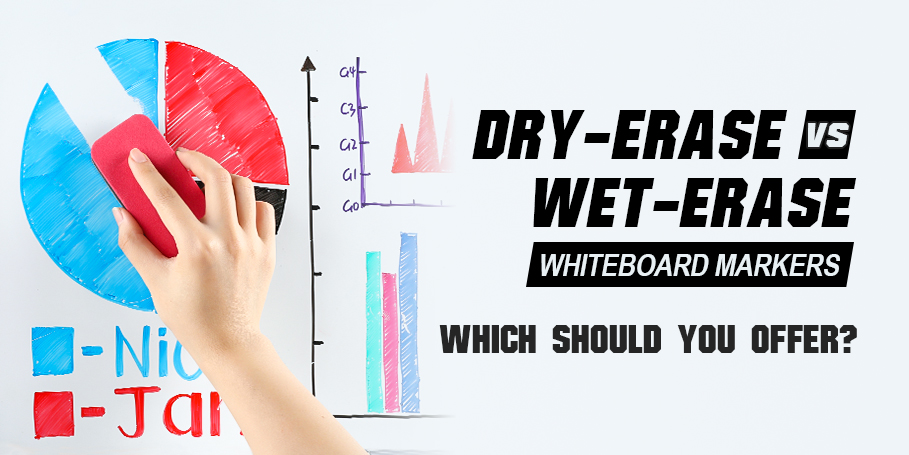
Dry-Erase vs. Wet-Erase Whiteboard Markers: Which Should You Offer?
Choosing between dry-erase and wet-erase markers is more than just a technical decision—it’s a product strategy. For B2B buyers, wholesalers, and OEM customers, understanding the key differences between these two types of whiteboard markers can help optimize your product line and meet market demand more precisely.
Both marker types are designed for non-permanent writing on non-porous surfaces, but they differ in ink formula, erasability, visual performance, and usage conditions. So, which one should you offer—or should you offer both?
What Are Dry-Erase Markers?
Dry-erase markers use an alcohol-based ink that contains color pigments and a quick-drying solvent. This formula allows users to write smoothly on whiteboards and similar non-porous surfaces, and erase the writing with a dry cloth, tissue, or eraser—hence the name “dry-erase.”
Dry-erase markers are widely used in:
- Offices and meeting rooms
- Classrooms and training centers
- Home and personal whiteboards
Pros:
- Easy to erase without water
- Dries quickly
- Vibrant color options
- Available in multiple tip types (bullet, chisel, fine)
Cons:
- Ink can smudge if touched before drying
- Can leave ghosting if not cleaned regularly
- Ink dries out faster when left uncapped
For customers seeking the best whiteboard pen for business or education, dry-erase markers are usually the top choice due to their convenience and cost-effectiveness.
What Are Wet-Erase Markers?
Wet-erase markers use a water-based or semi-permanent ink that requires a damp cloth for removal. The ink contains solvents like propylene glycol, which help it adhere better to surfaces and resist accidental smudging.
These markers are ideal for:
- Glass boards or laminated surfaces
- Outdoor whiteboards
- Signage, menus, or display boards
- Environments where writing must stay in place until intentionally removed
Pros:
- Does not smudge easily when touched
- More vivid, high-contrast colors (great for dark or glossy surfaces)
- Excellent for long-lasting but still removable writing
- Resistant to moisture and light rubbing
Cons:
- Requires water or cleaning solution to erase
- Not suitable for fast-changing notes or brainstorming sessions
- Slower to dry
Wet-erase markers are often chosen for visual permanence without going fully permanent, making them ideal for restaurant boards, reusable signage, or transport labeling.
Key Differences: Dry-Erase vs. Wet-Erase
| Feature | Dry-Erase Marker | Wet-Erase Marker |
|---|---|---|
| Ink Base | Alcohol-based | Water-based or semi-permanent solvent |
| Erasability | Wipes off with dry cloth/eraser | Requires damp cloth or cleaning solution |
| Smudge Resistance | Low – smudges easily if touched | High – resists accidental contact |
| Writing Surface | Whiteboards, melamine boards | Glass, laminated boards, displays |
| Color Brightness | Medium to high | Very high contrast, especially on black |
| Typical Use Case | Fast-paced environments, daily notes | Static content, signage, long display |
| User Preference | Teachers, office staff | Retailers, event planners, food industry |
Which One Should You Offer?
That depends entirely on your target customers and their usage scenarios.
- If your clients are schools, offices, or training providers, dry-erase markers are the most versatile and widely used option. They’re easier to clean and perfect for fast-paced communication.
- If your customers include restaurants, retailers, or logistics companies, wet-erase markers are more suitable for displays that should stay intact until intentionally changed.
For OEM buyers, you may even want to offer both, positioned as two solutions for different needs. You can highlight:
- Dry-erase for agility and quick updates
- Wet-erase for durability and clarity
This product diversification strengthens your catalog and appeals to a broader buyer base.
Can Dry- and Wet-Erase Markers Be Customized for OEM/ODM Orders?
Yes, absolutely. At Gxin, we offer full customization for both marker types, including:
- Ink formulation (alcohol-based, water-based, low-odor)
- Tip type (bullet, chisel, fine, brush)
- Barrel shape and size
- Cap design with eraser or magnetic features
- Custom logo printing and packaging
- Certifications for export (RoHS, EN71, ASTM)
Our OEM whiteboard marker guide also helps you select the best ink-to-tip combination for different market segments.
For example, a client focusing on hospitality supplies might opt for wet-erase pens with ultra-bright neon ink and fine tips for menu boards. An educational supplier may prefer dry-erase markers with long cap-off time and thick bullet tips for visibility in classrooms.





